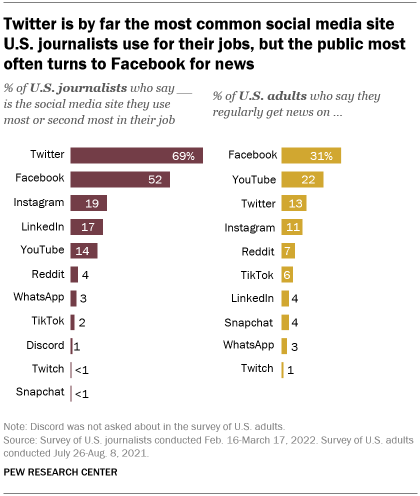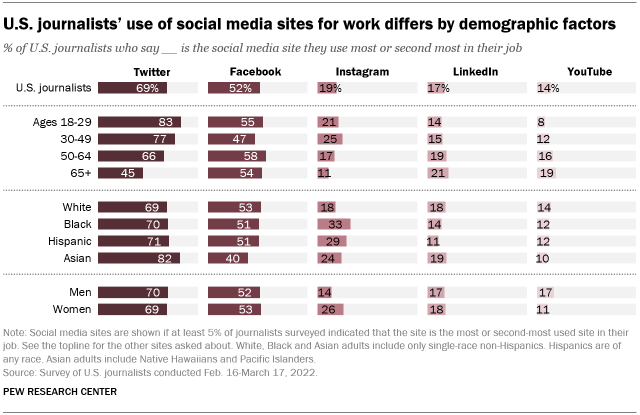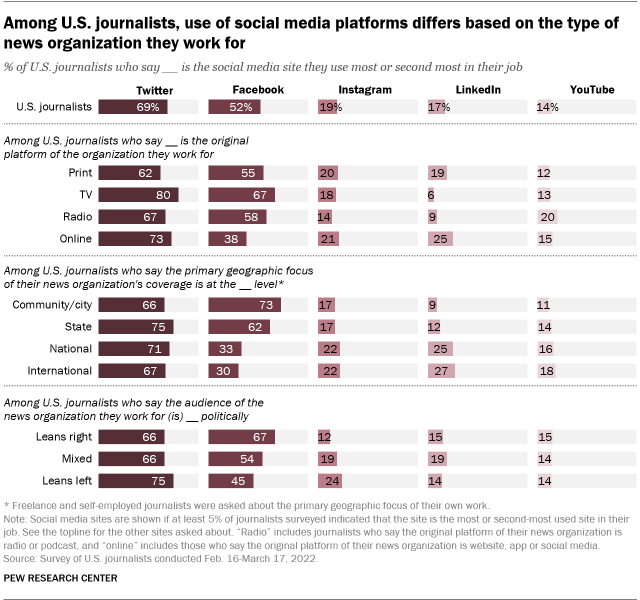Rubén Weinsteiner
More than nine-in-ten journalists in the United States (94%) use social media for their jobs, according to a recent Pew Research Center survey
of reporters, editors and others working in the news industry. But the
sites that journalists use most frequently differ from those that the
public turns to for news. 
Among
journalists, Twitter clearly ranks at the top of the list for
work-related tasks. Around seven-in-ten U.S. journalists (69%) say it is
the social media site they use most or second most for their job.
Twitter is followed by Facebook at 52% and, far lower on the list, by
Instagram (19%), LinkedIn (17%) and YouTube (14%). None of the other
sites asked about in the survey – Reddit, WhatsApp, TikTok, Discord,
Twitch and Snapchat – were named by more than 4% of the journalists
surveyed.
A different lineup emerges for the public.
Among Americans overall, Facebook is the most widely used social media
site for news, with 31% of U.S. adults saying they go there regularly
for news. YouTube is the second-most frequently used site, with 22% of
the public regularly getting news there. Fewer adults (13%) say they
regularly get news on Twitter, despite the platform’s widespread use
among journalists. Overall, a little under half of U.S. adults (48%) say
they often or sometimes get news from social media sites.
How we did this
Demographic differences in journalists’ use of social media platforms
Among
journalists, the use of social media for work purposes is common across
all age groups, but there are differences in the sites that are turned
to most frequently.
Twitter is a particular favorite among the
youngest journalists, with 83% of those ages 18 to 29 identifying it as
one of their most commonly used social media sites. In stark contrast,
45% of journalists 65 and older identify Twitter as one of their top two
social media sites for work tasks. Instagram is also more popular among
younger journalists (those under 50), while LinkedIn and YouTube are
somewhat more popular among older journalists (those ages 50 and older).

Looking
at race and ethnicity, Twitter is particularly popular among Asian
American journalists, with 82% saying it is one of their most commonly
used sites, compared with about seven-in-ten White (69%), Black (70%)
and Hispanic journalists (71%). A third of Black journalists cite
Instagram as one of the most common sites they use, as do 29% of
Hispanic journalists and 24% of Asian journalists – all statistically
higher than the 18% of White journalists who say the same.
Differences by the type of news organization journalists work for
The
social media sites that journalists use also often vary by the
characteristics of the news organizations they work for – including the
organization’s original platform, the audience’s political makeup and
the geographic focus of the organization’s work. 
Journalists
who say their organization started in television news stand out in
several areas. Two-thirds of journalists in that group say Facebook is
one of their most commonly used social media sites – the highest
percentage of any platform group and dramatically higher than the 38% of
those working at online organizations. Journalists who say they work
for organizations that originated on TV are also most likely to include
Twitter among their two most relied on sites (80% say this), while print
journalists are the least likely to say this (62%). At the same time,
television, as well as radio journalists, are less likely than online
and print journalists to say LinkedIn is one of their top two sites.
Journalists’
use of social media sites also varies by what they identify as the
political composition of their audience. Journalists who say they work
at an outlet whose audience leans right politically are much more likely
than those with left-leaning audiences to say Facebook is one of their
top two social media sites for their work (67% vs. 45%). Conversely,
journalists who say their organization has a left-leaning audience are
twice as likely as those who say their organization has a right-leaning
audience to use Instagram (24% vs. 12%).
The differences for
Twitter are not as large, but three-quarters of journalists who say they
work at an outlet with a politically left-leaning audience say it is
one of the sites they most commonly use, compared with 66% of
journalists whose organization’s audience tilts to the right
politically.
Among journalists who say they work at a news
organization with a community, city or county focus, Facebook is the
most commonly used social media platform; 73% say it is one of their top
sites. That number plunges to 33% among journalists at organizations
with a national focus and to 30% for those working for internationally
focused organizations.
Unlike Facebook, LinkedIn is more likely
to be used by journalists at nationally or internationally focused news
organizations. Around a quarter of journalists at national news
organizations (25%) and international news organizations (27%) count
LinkedIn among their most frequently used social media sites, compared
with only 9% of journalists at community-focused news outlets and 12% of
those working at outlets with a statewide focus. (Freelance and
self-employed journalists were asked about the geographic focus of their
work instead of the geographic focus of their organization’s work.).


אין תגובות:
הוסף רשומת תגובה